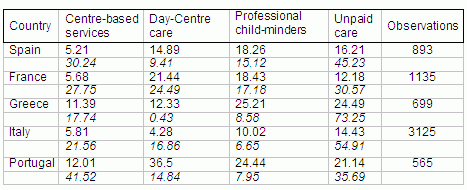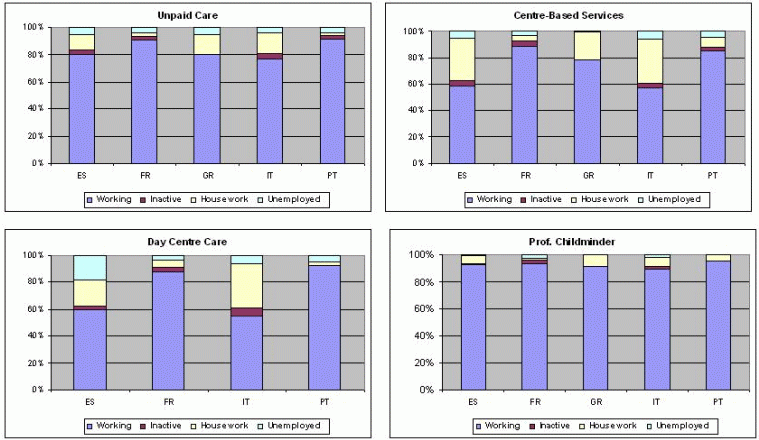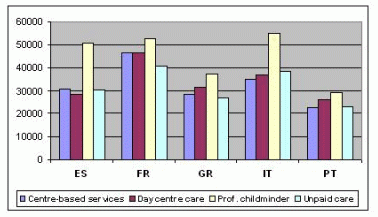A number of recent policies implemented by European governments have affected parental employment patterns. Their objectives included increasing mothers’ participation in the labour market, increasing the fertility rate, creating equal opportunities for women to access the labour market, and promoting the equal division of unpaid labour between men and women (Gauthier 2007).
Changes in culture and in policies have increased labour participation women. Many studies have established that institutional influence such as childcare is indeed instrumental in women's participation in the labour force (Esping-Andersen 2002; Del Boca 2006). The increased number of women in the labour force has made possible an egalitarian distribution of household tasks and growth in the use of non-parental childcare. Government subsidised childcare programs (in the form of pre- and after-school programs) and the help of informal arrangements (such as grandparents and professional child-minders) have enabled women to increasingly participate in paid employment, though more than 6 million women still don't work because of their family responsibilities (Eurostat 2006).
Decisions concerning the use of non-parental childcare depend on many economic and demographic factors, and the process by which these decisions are made has implications for the effectiveness of childcare policy. Efforts to increase the supply of childcare must take into account factors that parents consider important in their childcare choices.
Although family structure and employment patterns have changed in last twenty years, as married women increasingly entered the workforce and husbands took on more housework, large numbers of women still work at home in Mediterranean economies. In these countries, women are primarily responsible for unpaid work at home, and the family tradition is central. Childcare and other unpaid work are unequally shared among partners, even when mothers are employed full-time. I focus here on France, Italy, Spain, Portugal, and Greece.
Table 1 presents the maternal employment rate in 2005 with respect to age and number of children in southern Europe (Nicodemo and Waldmann 2009). Most mothers work, especially when their children go to school.
Table 1. Maternal employment rates, women age 15-64
Source: Eurostat 2005.
Non-parental childcare
Using 2006 data from the EU-SILC (European Income and Living Conditions) survey, I explore the connection between married women's labour force participation and childcare arrangements.
Childcare systems are organised differently across countries. Table 2 reports the average hours per week children spend in different types of care and in italics the percentage of children. At the Barcelona Summit in 2002, EU members set targets for providing formal childcare by 2010:
- 90% of children older than 3 years of age
- 33% of children under 3 years of age.
Childcare at centre-based services concerns only children who are at pre-school or at school if the childcare reference time is outside (pre) school hours. Childcare at day-care centre includes all kinds of care organised/controlled by a structure (public or private). Childcare by professional child-minders are direct arrangements between the care provider and the parents (parents are often employers and pay the care provider directly). Unpaid care is free or informal arrangements such as exchange of services (neighbours, friends, grandparents, etc.)
Table 2. Distribution of childcare arrangements
Source: EU-SILC 2006, Children between 0-14 age in pre or after school hours
Unpaid care is used in all countries. Greece and Italy are the countries where the percentage of children in unpaid care is highest (73.2% and 54.91%), and children spend 24 and 15 hours per week in such care, respectively. Most babies in France and Portugal stay in paid childcare, where children spend many hours during pre- and after-school hours, while children in Spain, Italy and Greece do not usually use these structures. Children spend a long time with professional child-minders in many countries, except Portugal and Italy where they spend around 8 hours per week. In Mediterranean countries, parents use informal childcare extensively, and countries such as Greece, Italy, and Spain are far from the Barcelona targets. These countries also have a low employment rate compared to France and Portugal.
Non-parental childcare arrangements are correlated with women participating in the labour market. As Figure 1 shows, about 80% of married working women use unpaid childcare and 50% use paid childcare, so females are likely sensitive to the cost of childcare when deciding to enter paid employment (see Figure 2). Furthermore, in countries such as Greece, Italy, and Spain, children spend fewer hours in paid childcare than in other southern European countries, but at the same time a surprisingly high percentage of women in these countries stay at home and use non-parental childcare arrangements. There are different explanations for these results. Perhaps strong family traditions, rather than cost, discourage women from using childcare. Or perhaps women in these countries work in the informal sector, so they are “homemakers” who have paying jobs and need childcare. Another explanation is that perhaps they believe that paid childcare is important for the education of their children.
Figure 1. Childcare arrangement by mother’s employment
Figure 2. Household income by childcare arrangements
Childcare and wage rate
These results are reinforced when I estimate the participation of mothers jointly with the type of childcare that they use. Mothers take childcare arrangements into account when making decisions about work, and, in particular, unpaid childcare has a big effect on the participation of women in the labour market. Women's labour supply and childcare arrangements are also influenced by the wage rate. The results indicate that hourly wages have a strong effect on the decision to work as well as to use both paid and unpaid childcare (see Table 3). Policies that increase the effective wage rate, such as benefits for poor families or reduced taxation on married women's earnings are likely to have a significant effect on the employment status.
Table 3. Impact of hourly wage on childcare and hours worked of women
Source: EU-SILC 2006. Note: p-values are 1% - ***; 5% **; 10% *;
Conclusions
Childcare facilities allow parents to take a job and decrease familial inequality, improving their quality of life and combating the risk of poverty. In particular, in Mediterranean countries, a free non-parental childcare arrangement (such as grandparents) is correlated with having more time to participate in the labour market and saving more income. But this is not sufficient to increase female labour force participation. In countries such as Italy, Spain, and Greece, children spend few hours in paid childcare compared with Portugal and France, countries with a high rate of female labour force participation. I suggest two contrasting explanatory forces. Family tradition may discourage the use of childcare or the childcare system may be inflexible due to high prices, low quality, or scarcity. I believe both likely hold in southern European countries. The fundamental role of unpaid childcare in these economies necessitates new strategies for improving childcare and increasing female labour force participation.
References
Alvarez, B and D Miles (2006). “Husbands Housework Time: Does Wives Paid Employment Make a Difference?” Investigaciones Economicas. vol. XXX (1), 2006, 5-31.
Del Boca, D (2006). “The effect of childcare and part time opportunities on participation and fertility decisions in Italy.” Journal of Population Economics.
Esping-Andersen, G (2002). Why we need a New Welfare State. Oxford, University Press.
Gauthier, A.H. (2007). “The impact of family policies on fertility in industrialized countries: a review of the literature”. Population Research and Policy Review.
Nicodemo, C and R Waldmann (2009). “Child-Care and Participation in the Labour Market for Married Women in Mediterranean Countries”. IZA Working Paper.








